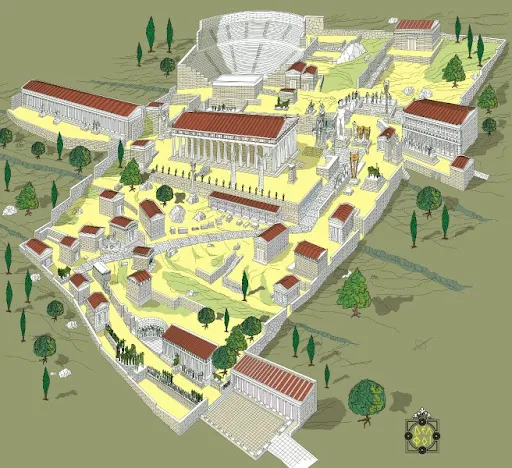the Treasury of the Sicyonians
14) the Treasury of the Sicyonians
Period: approx. 6th c. B.C.
Sicyon, was a city on the Peloponnesian coasts of the Corinthian Sea, which flourished during the Archaic period and the early 6th century B.C.
The name of "Sicyonian Treasury" is a generic name given to three different and successive buildings of the 6th century BC. The treasury itself replaced two former buildings as mentioned by Pausanias, namely the tholos and the monopteros, built by the same city at an earlier stage within the 6th century.
The earlier buildings were related to the victories of the tyrant Cleisthenes of Sicyon in the course of the First Sacred War. Their replacement probably marks the change in tide in Sicyonian politics.
The Treasury of the Sicyonians on the left of the Sacred Way (direction to the Temple of Apollo).
This open-sided, roofed structure was supported by fourteen small columns of doric order *: five columns on each longer side and four others on the smaller sides. They held a Doric frieze where triglyphs were placed only over the columns, resulting in fourteen metopes of unusual width sculpted in high relief and painted; detail was added with contrasting color and sometimes incision.
On the inside, there was no alcove and open as it was the building looked more like a shelter and thus it led to the conjecture that it hosted the chariot with which Cleisthenes, the tyrant of the Sicyon, won at the first Pythian games of 582 B.C.
This building, with its sculptural decorations, is the oldest one found in Delphi- including its five metopes that survived, which are of great importance to the history of art.
Of the original fourteen metopes, substantial portions of four as well as smaller fragments of others were found in 1894, scattered around the foundations of the later treasury. They show: 1) the Dioscuri, twins worshipped at the town of Sicyon, returning with others from a cattle raid; 2) The boar of Kalydon; 3) Zeus in the guise of a bull abducting Europa; 4) Jason’s ship Argo (illustrated). These myths have particular meaning for Sicyon but were still unusual subject matter, which is maybe why the names of the characters were originally added in paint. The sculptures are very inventive for their date. The Europa relief in particular is notable for capturing a fleeting moment, and for the female figure being in proportion to the animal; most archaic sculpture of this period was not concerned with the accuracy of relative sizes.
doric, ionian and corinthian order: are Greek architectural orders regarding the structure of an entablature. In each order the proportions of the subdivisions (architrave, frieze, cornice) are defined by the proportions of the column.
monopteros: is a circular colonnade supporting a roof but without any walls. Unlike a tholos (in its wider sense as a circular building), it does not have walls making a cella or room inside.
support us - buy the map!

The reconstruction map of Delphi, by the Archaeological Guide of Greece
Designed and produced for a convenient and handy use in site and at home, it will assist you to visualize the Sanctuary of Apollo, where theOracle of Delphi was, the Ancient Theater, the Stadion, the Gymnasion of Delphi and the Sanctuary of Athena Pronaia.
price: 20€






